6 Symptoms of Bad Spark Plugs (and What They Look Like)
Rough idle, misfires, and poor performance are just a few things that may indicate your spark plugs need attention. Bad spark plugs can make your car frustrating to drive and lead to engine damage if ignored long enough.
Keep reading to learn the most common symptoms of worn or failing spark plugs. We’ll also discuss how long spark plugs typically last and what their average replacement costs are so you can budget accordingly.

What Does a GOOD Spark Plug Look Like?
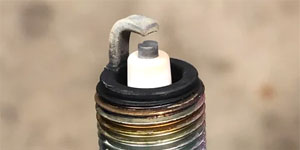 Here is a typical used spark plug that is still considered in “good condition”.
Here is a typical used spark plug that is still considered in “good condition”.
A light gray, yellow, or brown discoloration of the ceramic insulator around the center electrode, combined with a clean side electrode, indicates normal combustion is occurring. This shows that the optimal fuel-air mixture is burning properly inside the cylinder.
While there may be slight oil consumption taking place, evident by light deposits on the insulator tip, it is nothing to be concerned about as long as the spark plug is still firing correctly.
What Does a BAD Spark Plug Look Like?
Sooted/Carbon Fouled

The spark plug appears covered in a uniform layer of dark black carbon deposits.
This plug condition indicates the engine is operating too rich, meaning excess fuel is present. Potential causes include a dirty air filter, improperly functioning cold start fuel mixture controls, extensive short trips driving, or an incorrect spark plug heat range.
Oil Fouled
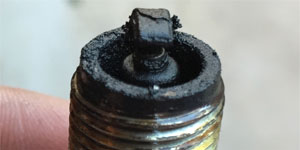
The spark plug appears coated in a glossy black oil residue that leaves wet deposits.
This oil fouling condition signals excessive oil is entering the combustion chamber during operation. Root causes can include an overfull crankcase, poorly functioning crankcase ventilation, or worn out piston rings and/or valve stem seals allowing oil to leak past.
See Also: 6 Causes of Oil on Spark Plug Threads
Lead Fouling
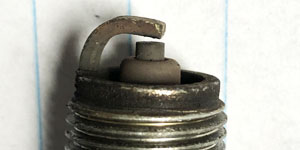
The spark plug shows glazing deposits of yellowish-brown color covering its inner surfaces. There may also be an underlying greenish hue visible. This glaze appears baked on, and could range from a thin coat up through completely caked on layers that have partially flaked off.
This lead fouling is caused by leaded fuel contamination, either from leaded gasoline or fuel additives containing lead compounds.
Ash Fouling

The spark plug appears covered in a thick, off-white ceramic-textured compound. This ash fouling deposit is quite brittle, and can be chipped off with a fingernail or pocket knife blade.
This type of buildup forms from excessive additive usage, whether from fuel treatments, oil detergents/stabilizers or other aftermarket engine chemicals. When burned in the combustion process, these additives leave behind a superfine white ash that fuses onto engine surfaces.
Center or Side Electrode Eroded/Melted Away
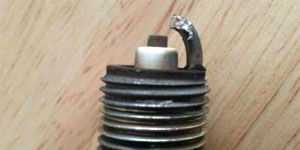
Significant material loss is evident on the spark plug’s center and/or side electrode. The electrodes appear eroded, rounded or melted away. The ceramic insulator tip may also be blistered, softened or cracked.
This type of thermal damage occurs when the plug overheats from extreme combustion temperatures. Typical causes include low fuel octane, excessive spark advance timing, pre-ignition events, lean air-fuel ratios, or incorrect spark plug heat range.
Heavy Wear of Center Electrode
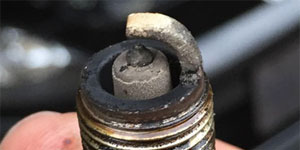
Examination shows the spark plug’s center electrode exhibits substantial erosion, wearing away the material significantly or completely in severe cases.
This heavy electrode wear indicates the plug has exceeded its usable service life. Other potential causes could be an overly wide spark gap or incorrect heat range spark plug installed.
Heavy Wear on Side Electrode

Upon inspection, the spark plug’s side electrode shows significant wearing away and erosion of the metal. In advanced cases, nearly all electrode material has vaporized.
This accelerated sideways wear typically results from detonation damage inside the cylinder. Root causes include low fuel octane, pre-ignition events, or excessive oil/fuel additive usage.
Center Electrode Insulator Nose Fractured
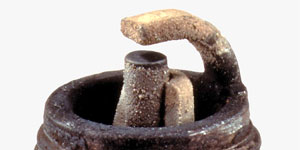
Upon visual inspection, a piece of the ceramic insulator nose around the center electrode appears chipped or fractured off. This leaves a gap or missing section in the insulator tip.
Potential root causes for this structural cracking and material loss include: damage from dropping , buildup of excessive conductive deposits partially bridging the center electrode, or a spark plug that has simply exceeded its usable service lifespan.
Bad Spark Plug Symptoms
Since bad spark plugs can lead to misfires (one of the symptoms), many of the general red flags overlap. If you suspect that you have a faulty spark plug, it’s important to get your vehicle examined by a mechanic sooner rather than later.
See Also: 4 Signs You Have a Bad Spark Plug Wire
#1 – Misfires

Misfires occur when there is a problem with combustion of the air fuel mixture inside a cylinder. A misfire can happen when the mixture ignites early, late, or not at all.
Unburnt fuel can cause increased exhaust emissions which are harmful to the environment and make the tailpipe smell strongly of fuel. Engine damage is inevitable when misfires go uncorrected.
Related: Other Causes of Engine Misfires
#2 – Rough and/or Loud Idle (with Vibration)

Vehicles with bad spark plugs may have a rough or loud idle and may or may not vibrate with it. This happens because unburned fuel from misfires caused by faulty spark plugs confuses the O2 sensors.
This leads to them removing fuel from the cylinder which results in a lean mixture. Running lean leads to a rough idle and more misfires.
During a rough idle you may notice that the RPM is jumping. This can be seen on a tachometer on the dashboard or heard by listening to the engine.
Higher-pitched sounds are from higher revs while low-pitched sounds are from lower revs. The jumping results from the engine control unit (ECU) trying to compensate for the problems.
#3 – Rough and/or Slow Acceleration

Abnormal response to the gas pedal is especially noticeable when hard acceleration is needed. Hesitation when accelerating is another issue that’s caused by misfires that result in a lean mixture of air and fuel.
If you notice your car bog or stumble when you suddenly stab the gas, this may indicate you need new spark plugs.
#4 – Poor Fuel Economy
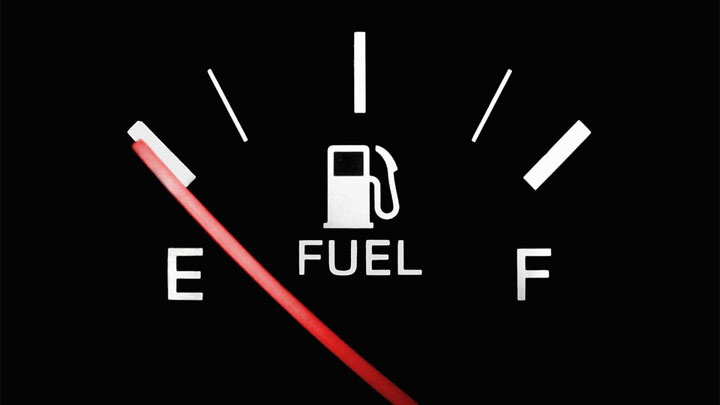
Having a rich air/fuel mixture or a misfiring cylinder is inefficient and wasteful. The vehicle needs to use more fuel to maintain the same level of performance that the driver is asking for, since some fuel is leaving the vehicle unburned or is combusting in the wrong part of the system where it doesn’t add any power.
It’s always a good idea to track the fuel consumption of your vehicle. There are many potential causes of poor fuel economy but a sudden dip in fuel economy can indicate dirty or broken spark plugs.
#5 – Difficulty Starting Vehicle

Bad spark plugs can cause a vehicle to stall or struggle when trying to start. To overcome the inertia when the car is sitting still takes a relatively large input of energy, which is why this when the vehicle may struggle the most.
If the vehicle fails to start completely the issue is likely with the battery rather than spark plugs, since spark plugs don’t usually all fail at the exact same time.
#6 – Check Engine Light
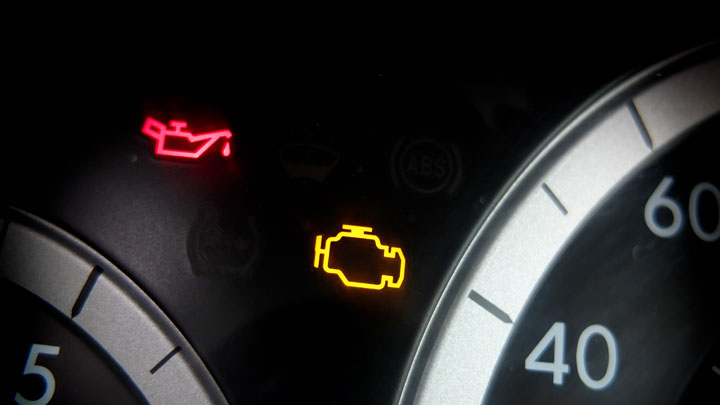
A spark plug that fails will trigger a misfire that causes the check engine light to illuminate on the dashboard. The ECU will generate a code that can be checked using an OBD2 reader on vehicles made in 1996 and newer. There are a variety of spark-related trouble codes that may appear (ie: P0351 Code).
What Does a Spark Plug Do?

Spark plugs are the components of an internal combustion engine which use the electrical signal that goes from the battery to the ignition coil to create sparks that ignite the mixture of air and fuel in each cylinder.
The electrical current travels through the spark plug and jumps the gap at the end of the spark plug, forming an arc of electricity, if the current is high enough. This arc is the spark that ignites the flammable mixture.
Spark plugs can stop working for a number of different reasons. Anything that interrupts the flow of electricity, such as buildup of oil, fuel, or carbon, can cause a malfunction.
Having an incorrect gap will likely cause problems. Spark plugs wear over time so an old plug may have an excessive gap.
Some people choose to “gap” their spark plugs, or bend them to have the correct gap. This is an option for knowledgeable car owners to prolong the life of their plugs.
Sometimes the wrong spark plug is installed in the vehicle, so the heat range will be different. This can cause a problem as well.
Of course, damaged plugs may not work. Sometimes they can be corroded or burned from long life or harsh conditions.
Related: How to Check Spark Plugs and Their Conditions
How Long Do Spark Plugs Last?
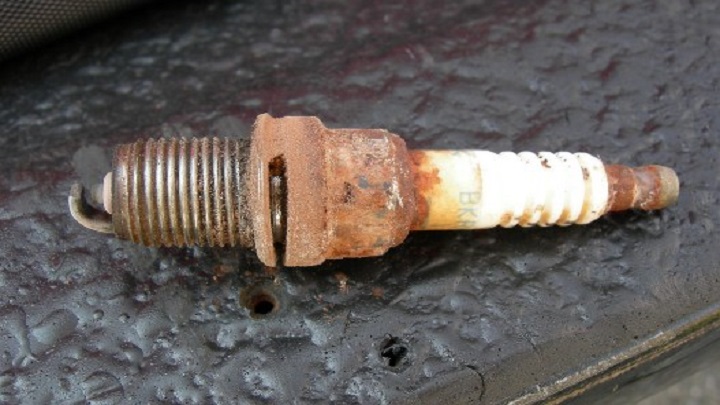
New spark plugs come with a recommended lifespan. For most vehicles, this is 30,000 to 80,000 miles. Even advertised “extended life” spark plugs still wear down. They may last 100,000 miles but be severely worn by then, which means they may still work but not very well.
See Also: Types of Spark Plugs Comparison
Prevention is best! It’s good practice to check the spark plugs on the vehicle every 30,000 miles. If they are accessible in your vehicle, simply remove each one via a spark plug socket and visually examine them.
Good spark plugs should look similar new ones but just a bit dirtier. They may have a red coating on the ceramic insulation, which is from fuel additives in some types of gasoline. This won’t affect the function of the plugs.
Fuel-fouled spark plugs have a sheen on the side and tip electrodes caused by too-rich mixture (too much fuel for the amount of air in the cylinder), a plug heat range that’s set too low for the engine, or problems with the ignition. Carbon-fouled plugs have blackened tip and side electrodes.
Pre-ignition damage shows that the side electrode has been burned away. Worn plugs have either a too-large gap or general signs of wear. Mechanical damage can happen when the plug extends too far into the cylinder and can cause the plug to look very beat up.
Related: What is a Spark Plug Blow Out and How Can You Prevent It?
Average Spark Plug Replacement Cost
Best places to order parts? See: 19 Best Online Auto Parts Stores
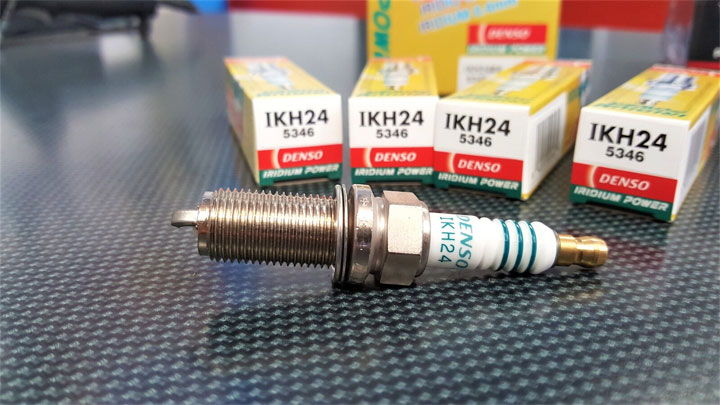
When replacing spark plugs, it’s important to use the same type of spark plug that the vehicle previously used. There are many types – copper, single platinum, double platinum, silver, and iridium.
Each has different strengths and properties which are best for certain vehicles, and some are more expensive. Check the vehicle’s manual or contact an authorized dealer to know which type your vehicle should use.
Related: Best Spark Plugs for Gas Mileage and Performance
Some people elect to only change the spark plug that is causing the problem (identifiable by the code that the ECU throws or by visual assessment) while others change all of the plugs at once. Spark plugs are sold individually so know how many you need before buying them.
Spark plugs are usually less than $10 each. Having them installed by a professional can cost from $50 to $200 in labor, or you can do it yourself relatively easily for free. In most vehicles, the spark plugs are very easy to access.
If you tackle this job yourself, you’ll want to consult a repair manual to determine the proper torque spec for the spark plugs.
Spark plugs usually thread into an aluminum head. Since aluminum is a fairly soft material, it is easy to strip the head by cross threading or over tightening the spark plugs. This means you either need to re-tap a bigger hole or buy a new head, which will not be a cheap mistake.
- Replace the Engine or Replace the Car? (11 Factors to Consider) - Apr 11, 2024
- Plastic Piece Dragging Under Your Car? (What It Is and What To Do) - Mar 21, 2024
- Timing Belt vs Timing Chain (What’s the Difference?) - Feb 27, 2024

Or you can just change them out one at a time yourself and even if you’re changing out your spark plug cables to your distributor just doing one at a time that way you get them right and everything’s the same and then it don’t cost you nothing but the price of the and then it don’t cost you nothing but the price of the spark
Good information just like what i was experiencng with my car as a result of overdue plugs.
likes of : popping of check engine light,
uneconomical fuel consumption,
hard start,
smell of gas at times,
but not to the level of misfiring
thanks a lot. Appreciate.
Thanks for the feedback, glad the article helped you out.
how much do you charge to change spark plugs? i have a 2012 toyota corolla and Triple A suggest i change spark plugs and do the transmission flush like real soon….i’m almost at 100K but not yet. Hi KIM!! (Lisa Beasley)
The replacement cost should run you between $100 and $250 if you bring your car to a local mechanic.